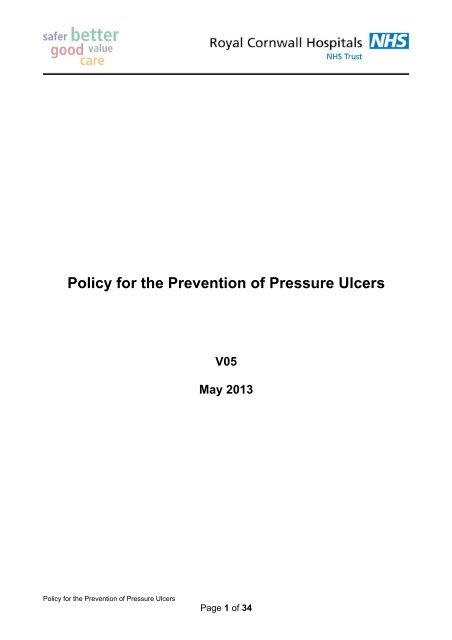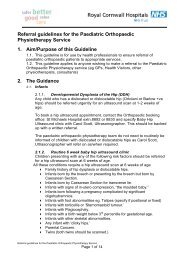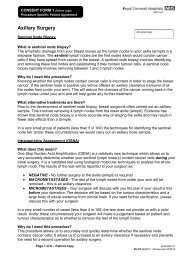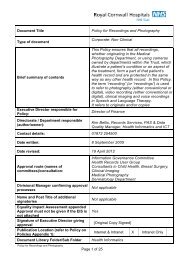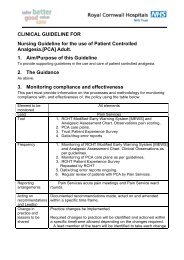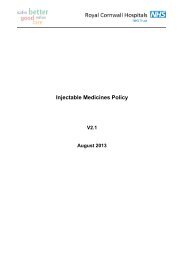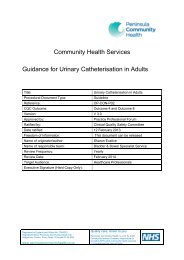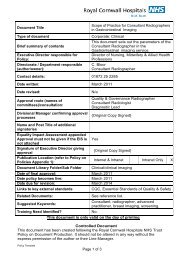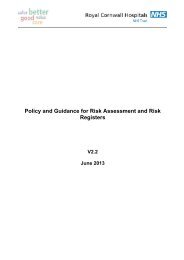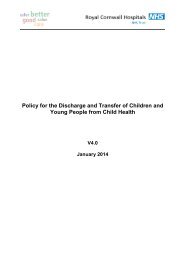Pressure ulcer prevention policy - the Royal Cornwall Hospitals ...
Pressure ulcer prevention policy - the Royal Cornwall Hospitals ...
Pressure ulcer prevention policy - the Royal Cornwall Hospitals ...
You also want an ePaper? Increase the reach of your titles
YUMPU automatically turns print PDFs into web optimized ePapers that Google loves.
Policy for <strong>the</strong> Prevention of <strong>Pressure</strong> UlcersV05May 2013Policy for <strong>the</strong> Prevention of <strong>Pressure</strong> UlcersPage 1 of 34
Table of Contents1. Introduction ................................................................................................................... 42. Purpose of this Policy/Procedure .................................................................................. 43. Scope ........................................................................................................................... 44. Definitions / Glossary .................................................................................................... 45. Ownership and Responsibilities .................................................................................... 46. Standards and Practice ................................................................................................ 56.1. <strong>Pressure</strong> Ulcer Prevention Principles of Practice .................................................. 56.3. Risk Assessment ................................................................................................... 66.48. Skin Assessment ............................................................................................. 106.51. Grading <strong>Pressure</strong> Damage .............................................................................. 116.54. Management of <strong>Pressure</strong> Ulcers ...................................................................... 116.58. Patient Information ........................................................................................... 126.63. Patient Repositioning ....................................................................................... 126.70. Care of Patients Nursed on Trolleys ................................................................ 136.76. Patient Nutrition ............................................................................................... 136.78. Patient Continence ........................................................................................... 136.80. Equipment Selection ........................................................................................ 146.88. Obtaining Equipment ....................................................................................... 146.96. Discharge of Patients Requiring Specialist Equipment .................................... 156.107. Cleaning & Decontamination of Equipment and Reporting Faults ................... 166.117. Reporting of <strong>Pressure</strong> Damage ........................................................................ 176.124. Audit/ Monitoring .............................................................................................. 186.126. Complaints and Legal ...................................................................................... 187. Dissemination and Implementation ............................................................................. 188. Monitoring compliance and effectiveness ................................................................... 189. Updating and Review .................................................................................................. 1910. Equality and Diversity .............................................................................................. 1910.2. Equality Impact Assessment ............................................................................ 19Appendix 1-<strong>Pressure</strong> Ulcer Prevention Clinical Pathway ................................................... 20Appendix 2- <strong>Pressure</strong> Relieving Equipment Selection Guidelines ..................................... 21Appendix 3- Range of Equipment Guide ........................................................................... 22Appendix 4- Serious Incident (SI) Reporting Process ........................................................ 23Appendix 5-Standard Operating Procedure (SOP)- RCHT <strong>Pressure</strong> Ulcer Prevention DataCollection ........................................................................................................................... 24Appendix 6- Complaints Response Process ...................................................................... 28Policy for <strong>the</strong> Prevention of <strong>Pressure</strong> UlcersPage 2 of 34
Appendix 7- Legal Claims Response Process ................................................................... 29Appendix 8. Governance Information ................................................................................ 30Appendix 9.Initial Equality Impact Assessment Screening Form ....................................... 32Policy for <strong>the</strong> Prevention of <strong>Pressure</strong> UlcersPage 3 of 34
1. Introduction1.1. This <strong>policy</strong> sets out <strong>the</strong> framework to guide evidence based care in <strong>the</strong><strong>prevention</strong> and management of pressure <strong>ulcer</strong>s.1.2. This version supersedes any previous versions of this <strong>policy</strong>.2. Purpose of this Policy/Procedure2.1. The purpose of this <strong>policy</strong> is to ensure that <strong>the</strong> Trust meets best practicestandards for <strong>the</strong> <strong>prevention</strong> and management of pressure <strong>ulcer</strong>s in line with national,regional and local guidelines.2.2. Implementation of this <strong>policy</strong> will help to ensure that:• There is clear guidance to ensure that <strong>the</strong> <strong>prevention</strong> and management ofpressure <strong>ulcer</strong>s is standardised across <strong>the</strong> Trust.• All staff act in accordance with this <strong>policy</strong> to prevent <strong>the</strong> development ofpressure <strong>ulcer</strong>s or to prevent <strong>the</strong> deterioration of existing pressure damage.3. ScopeThis document is applicable to all staff regardless of grade or profession, working within aclinical setting, caring for patients with, or at risk of, pressure <strong>ulcer</strong>s.4. Definitions / Glossary4.1. <strong>Pressure</strong> Ulcer – ‘Localised injury to <strong>the</strong> skin and/or underlying tissue usuallyover a bony prominence, as a result of pressure, or pressure in combination withshear. A number of contributing or confounding factors are also associated withpressure <strong>ulcer</strong>s; <strong>the</strong> significance of <strong>the</strong>se is yet to be elucidated.’ (EPUAP 2009)4.2. Unavoidable – ‘Unavoidable’ means that <strong>the</strong> person receiving care developed apressure <strong>ulcer</strong> even though <strong>the</strong> provider of <strong>the</strong> care has evaluated <strong>the</strong> personsclinical condition and pressure <strong>ulcer</strong> risk factors; planned and implementedinterventions consistent with <strong>the</strong> persons needs and goals, and recognised standardsof practice; monitored and evaluated <strong>the</strong> impact of <strong>the</strong> interventions and revised <strong>the</strong>approaches as appropriate; or <strong>the</strong> individual person refused to adhere to <strong>prevention</strong>strategies in spite of education of <strong>the</strong> consequences of non-adherence.5. Ownership and Responsibilities5.1. Role of all staff- to be responsible for acting to reduce <strong>the</strong> number of patientsdeveloping pressure <strong>ulcer</strong>s and achieving “no avoidable pressure <strong>ulcer</strong>s in NHScare” (Department of Health, 2009).5.1.1. All staff must act to achieve <strong>the</strong> Principles of Practice outlined inSection 6.5.1.2. All staff will be responsible for reporting pressure <strong>ulcer</strong>ation inaccordance with this <strong>policy</strong>.Policy for <strong>the</strong> Prevention of <strong>Pressure</strong> UlcersPage 4 of 34
5.2. Role of <strong>the</strong> Tissue Viability service- to advise and support staff in achieving <strong>the</strong>principles of practice through visible role modelling and clinical support in practiceand through education and training in <strong>the</strong> form of study days, self-directed learningresources, and practical workshops.5.3. Role of <strong>the</strong> Equipment Library- to supply equipment to protect patients’ skinintegrity whilst in hospital. Nursing staff will be responsible for requesting anddocumenting <strong>the</strong> use of equipment.6. Standards and Practice6.1. <strong>Pressure</strong> Ulcer Prevention Principles of Practice6.2. All staff must adhere to <strong>the</strong> following principles of practice to ensure care isdelivered in accordance with <strong>the</strong> best available evidence and every possible step istaken to reduce <strong>the</strong> risk of pressure <strong>ulcer</strong>s occurring.• All patients will be assessed for <strong>the</strong>ir risk of pressure <strong>ulcer</strong> developmentand any existing pressure damage immediately, within four hours ofadmission to hospital, when <strong>the</strong>ir condition changes, and on transfer ordischarge. This will be documented in <strong>the</strong> patient’s record andcommunicated as part of <strong>the</strong> nursing handover using <strong>the</strong> Waterlow riskassessment tool for adults, <strong>the</strong> Glamorgan score for paediatrics and <strong>the</strong>Maternity <strong>Pressure</strong> Ulcer risk assessment for maternity patients.• All patients will have a skin assessment carried out immediately, withinfour hours of admission, and throughout <strong>the</strong>ir stay according to <strong>the</strong> clinicalpathway (Appendix 1). This will be documented on <strong>the</strong> Risk Assessmenttool on admission and <strong>the</strong> skin assessment tool throughout <strong>the</strong>ir stay.• Any pressure <strong>ulcer</strong>s present on admission must be documented at <strong>the</strong> topof <strong>the</strong> Waterlow risk assessment tool and reported on <strong>the</strong> Safety Crossand on Datix.• Where a patient develops pressure <strong>ulcer</strong>ation during <strong>the</strong>ir hospital stay thismust be reported on <strong>the</strong> safety cross and as a clinical incident. If <strong>the</strong>pressure <strong>ulcer</strong> deteriorates during <strong>the</strong>ir stay <strong>the</strong> Datix must be updated.The risk and patient safety team can do this for staff. If a Grade 3 or 4pressure <strong>ulcer</strong> this is investigated as a Serious Incident and patients are tobe informed according to <strong>the</strong> Being Open <strong>policy</strong>• <strong>Pressure</strong> damage must be described on <strong>the</strong> wound assessment tool bystating <strong>the</strong> Grade of damage, <strong>the</strong> site of damage, <strong>the</strong> size of <strong>the</strong> damagedarea and <strong>the</strong> condition of <strong>the</strong> wound bed.• Where a patient is at risk of pressure damage a pressure <strong>ulcer</strong> <strong>prevention</strong>care plan must be written in agreement with <strong>the</strong> patient.• Patients, carers and relatives must be made aware of <strong>the</strong> reason for <strong>the</strong>assessment and intervention, and provided with <strong>the</strong> Trust informationleaflet RCHT 153.Policy for <strong>the</strong> Prevention of <strong>Pressure</strong> UlcersPage 5 of 34
• Patients, carers and relatives must be involved in decision makingregarding pressure area care and <strong>the</strong> use of devices to prevent and/ortreat pressure <strong>ulcer</strong>ation.• Communication with all members of <strong>the</strong> multi-disciplinary team involved incaring for <strong>the</strong> patient at risk of pressure damage is vital to ensure promptrecovery and optimum management of pressure areas across caresettings.• All patients at risk of pressure damage must have regular CARE roundsand skin assessments and immediate action must be taken if any signs ofpressure damage are identified. See Appendix 1 for clinical pathway for<strong>prevention</strong> of pressure <strong>ulcer</strong>s.• Where necessary action will be taken to improve patients’ nutritionalstatus.• Where moisture may impact upon skin integrity and contribute to pressuredamage (i.e. incontinent patients) action must be taken to protect <strong>the</strong> skin.Skin breakdown from moisture is not classified as pressure damageunless pressure, shear and / or friction damage is also present.• Patients at risk of pressure damage must be advised to keep moving or berepositioned as determined by individual assessment and skin condition.This is incorporated within <strong>the</strong> principles of <strong>the</strong> SKIN bundle and will bedocumented in <strong>the</strong> patient records. S – surface. K – keep moving, I –incontinence, N – nutrition.• All patients assessed as at risk of pressure damage must be nursed onhigh density foam, pressure reducing mattresses.• Patients with a very high risk or with pressure <strong>ulcer</strong>s grade 2 or abovemust be provided with an alternating pressure replacement mattress.• Specialist equipment will be available 24 hours a day, seven days a week• Patients at high risk of pressure <strong>ulcer</strong>ation should not sit out in a chair formore than two hours at a time and an appropriate pressure reducingcushion must be used.• All care provided to prevent pressure damage must be recorded in <strong>the</strong>patient’s records and evaluated to determine <strong>the</strong> need for fur<strong>the</strong>rintervention.• All health care professionals are required to attend education aboutpressure <strong>ulcer</strong> <strong>prevention</strong> and use of pressure relieving equipment.6.3. Risk Assessment6.4. For adults, excluding women in labour, <strong>the</strong> Waterlow Risk AssessmentCalculator must be used. This is to encourage a structured approach to <strong>the</strong>identification of a patient’s risk of developing pressure <strong>ulcer</strong>s. It should be used inPolicy for <strong>the</strong> Prevention of <strong>Pressure</strong> UlcersPage 6 of 34
conjunction with a nurse’s clinical judgement and experience. The Waterlow riskassessment tool forms part of <strong>the</strong> patient assessment documentation. Whenpossible it should be completed with involvement of <strong>the</strong> patient and/or carers toensure accurate collection of data (Anthony et al 2003).• Immediately, or within six hours of admission• On transfer of a patient to ano<strong>the</strong>r clinical area/environment of care• Prior to discharge from hospital• If a patient’s condition changes• Weekly, if <strong>the</strong> Waterlow score is 10 – 14• Every three days if <strong>the</strong> Waterlow score is 15 – 19• Daily if <strong>the</strong> Waterlow score is 20 or greater.6.5. For maternity patients, <strong>the</strong> Maternity Risk Calculator must be used according to<strong>the</strong> guidance provided as part of <strong>the</strong> Pregnancy and Birth Hand held record.(CHA2624)6.6. For paediatric patients, <strong>the</strong> Glamorgan Risk Assessment Scale must be used.(CHA2957)6.7. When assessing risk, <strong>the</strong> following factors must be considered (EPUAP 2009):• Activity and Mobility• Nutrition• Skin Condition• Perfusion and oxygenation of <strong>the</strong> tissues• Age• Build/weight for height• Continence• Tissue Malnutrition• Surgery• Neurological Deficit6.8. Activity and mobility6.9. Consider all individuals who are bedfast and/or chairfast to be at risk ofdeveloping pressure <strong>ulcer</strong>s (EPUAP 2009).6.10. Chair bound patients have almost 50% of <strong>the</strong>ir weight on only 8% of <strong>the</strong>ir body,<strong>the</strong>refore <strong>the</strong> sacrum and buttocks are at increased risk of damage (Collins 1999).6.11. Restlessness and fidgeting may cause blistering and abrasions to <strong>the</strong> skin’ssurface.6.12. Traction or splints reduce one’s ability to reposition. In addition <strong>the</strong>y may ruband cause damage to <strong>the</strong> surface of <strong>the</strong> skin and underlying tissues.6.13. When patients are sedated, unconscious or unable to move staff must takeresponsibility for protection from pressure damage.6.14. NutritionPolicy for <strong>the</strong> Prevention of <strong>Pressure</strong> UlcersPage 7 of 34
6.15. Reduced weight, impaired nutritional intake, dehydration and low serumalbumin levels may increase <strong>the</strong> risk of pressure <strong>ulcer</strong> development (Ferguson et al2000). However under nutrition is a reversible risk factor (EPUAP 2009).6.16. Nutritional indicators include anaemia, haemoglobin and serum albumin levels,measurement of nutritional intake (e.g. food charts) and weight. Weight loss mayresult in loss of fatty tissue and muscle wastage, which can increase pressure onbony prominences. Good nutrition and hydration is vital for maintenance of skinfunction and <strong>prevention</strong> of pressure damage. Protein is required for cell metabolismand <strong>the</strong> production of collagen, which gives <strong>the</strong> skin its strength.6.17. Carbohydrates and fats allow <strong>the</strong> body to use protein efficiently, generating newcells and reducing <strong>the</strong> risk of breakdown.6.18. Iron, zinc, vitamin A, C, B1, B2 and B6 are also required for collagen syn<strong>the</strong>sis.6.19. Nutritional assessment using <strong>the</strong> MUST (Malnutrition Universal Screening Tool)tool must be carried out on all patients on admission and weekly <strong>the</strong>reafter. Forpatients who score as medium or high risk of malnutrition commence a nutritionalcare plan and refer to <strong>the</strong> dietician if necessary to ensure optimal nutritional supportfor patients (EPUAP 2009).6.20. Be aware that <strong>the</strong> MUST may not give a high score for obese patients who maybe at increased risk of developing pressure <strong>ulcer</strong>s.6.21. Skin Condition6.22. All individuals with alterations to intact skin are at risk of developing pressuredamage. This includes dry skin, ery<strong>the</strong>ma, excessive moisture and non-blanchingery<strong>the</strong>ma.6.23. Incontinent patients may have permanently moist skin. This reduces <strong>the</strong>irtolerance of pressure shear and friction. Moist skin is 5 times more likely to breakdown than healthy skin (Gibbon 2009).6.24. Patients with thin friable skin are at increased risk of blistering or abrasions.6.25. Dry skin is at risk of cracking when under pressure.6.26. Oedematous skin may have a reduced blood or lymphatic supply, resulting intoxins building up in <strong>the</strong> tissues. Oedema can leak onto <strong>the</strong> skin causing macerationand increasing <strong>the</strong> risk of breakdown.6.27. Discolouration may indicate poor blood supply or early pressure damage andpressure relief or a change of position is required.6.28. A break in <strong>the</strong> skin should only be recorded on <strong>the</strong> Waterlow score if it is due topressure damage.6.29. Perfusion and Oxygenation of <strong>the</strong> TissuesPolicy for <strong>the</strong> Prevention of <strong>Pressure</strong> UlcersPage 8 of 34
6.30. Factors affecting perfusion include diabetes, cardiovascular instability,norepinephrine use, low blood pressure, reduced ankle brachial pressure index anduse of oxygen (EPUAP 2009).6.31. Age6.32. As <strong>the</strong> skin ages <strong>the</strong> amount of collagen and elastin in <strong>the</strong> dermis reduces. Thisresults in thinning of skin, loss of tensile strength and increased risk of breakdown(Wounds UK 2008).6.33. Build/weight for height6.34. Distribution of weight requires consideration and bariatric patients may be atrisk of pressure damage. Where excess weigh occurs on specific areas of <strong>the</strong> body<strong>the</strong>re may be an increased risk of deep pressure damage secondary to friction.6.35. If weight is below average <strong>the</strong> amount of tissue covering bony prominences isreduced, resulting in a concentration of pressure onto a smaller area.6.36. Continence6.37. Moisture on <strong>the</strong> surface of <strong>the</strong> skin can result in maceration and <strong>the</strong> skin is lessable to resist damage (Cutting and White 2002). Urine and faecal fluid causechanges in <strong>the</strong> skin’s pH and reduces its tensile strength, this can <strong>the</strong>n make it moresusceptible to pressure <strong>ulcer</strong>ation (see skin condition above).6.38. Tissue Malnutrition6.39. Some conditions can reduce blood flow through <strong>the</strong> arteries and capillaries.This can result in poor perfusion of <strong>the</strong> tissue. The addition of pressure whencirculation is already poor can increase <strong>the</strong> risk of damage.6.40. Surgery6.41. Immobility during and after surgery may result in pressure damage. The longer<strong>the</strong> surgery, <strong>the</strong> greater <strong>the</strong> risk of pressure damage (Clinch 1996). Some patientsmay need to be cared for in certain positions post operatively, (e.g upright) limiting<strong>the</strong> extent to which <strong>the</strong>y can be repositioned.6.42. Anaes<strong>the</strong>tics and analgesia can prevent patients from experiencing painassociated with pressure damage. It is important to inform <strong>the</strong>m that <strong>the</strong>y may be atrisk and closely monitor skin condition.6.43. Patients undergoing surgery will have a raised Waterlow score for 48 hours postoperatively however this may be for longer if <strong>the</strong>ir post-operative recovery is slow.6.44. Neurological Deficit6.45. Damage to <strong>the</strong> nerves can prevent patients being aware that <strong>the</strong>y areexperiencing pressure damage.6.46. O<strong>the</strong>r factors requiring consideration are:Policy for <strong>the</strong> Prevention of <strong>Pressure</strong> UlcersPage 9 of 34
• Acute, chronic or terminal illness• Co-morbidity, (e.g. pain, infection, medication)• Body temperature• Posture• Psychosocial issues• Exposure to pressure, shear or friction prior to admission6.47. When a patient is identified as at risk of pressure <strong>ulcer</strong>ation action is required toreduce or manage <strong>the</strong> risks to prevent tissue damage occurring. The followingsections focus upon risk management and <strong>the</strong> <strong>prevention</strong> of tissue damage.6.48. Skin Assessment6.49. The key principles of skin assessment are as follows:• All patients to have a top to toe skin assessment immediately or within sixhours of admission to hospital. Following a lower limb fracture,assessment must be undertaken within one hour of admission. This is tobe recorded on <strong>the</strong> Waterlow assessment page in <strong>the</strong> patient profile bycircling YES or NO and recording <strong>the</strong> skin condition in <strong>the</strong> specificpressure damage box at <strong>the</strong> bottom of <strong>the</strong> page.• All patients to have a repeat skin assessment following transfer to a newclinical area or to <strong>the</strong>atre. This is to be recorded on <strong>the</strong> skin assessmentsheet which is found on <strong>the</strong> back of <strong>the</strong> CARE round documentation.(CHA3061)• Following admission, all patients at risk of pressure damage, Waterlow 10-14, require a daily skin assessment.• For all patients at high risk of pressure damage, Waterlow 15-19, a twicedaily skin assessment is required.• For all patients at very high risk of pressure damage, Waterlow 20+, athree times daily skin assessment is required.• All ongoing skin assessments must be recorded on <strong>the</strong> skin assessmentsheet which is found on <strong>the</strong> back of <strong>the</strong> CARE round documentation.• A daily skin assessment should be viewed as a minimum standard.6.50. Maintaining healthy skin: The following principles should be considered inmaintaining healthy skin:• Keep <strong>the</strong> skin clean and dry, but do not let it dry out.• Avoid excessive moisture from urine, faeces, wound exudates, saliva andperspiration, as this can increase <strong>the</strong> risk of friction and shearing, reduceskin integrity and lead to maceration.• Cleanse <strong>the</strong> skin with a soap substitute.Policy for <strong>the</strong> Prevention of <strong>Pressure</strong> UlcersPage 10 of 34
• Use emollients on a regular basis to prevent skin dehydration.• Avoid using talcum powder and excessive rubbing of <strong>the</strong> skin.• Use skin barrier products topically to protect <strong>the</strong> skin from excessivemoisture and potential irritants.• Ensure that <strong>the</strong> patient has adequate nutritional and fluid intake.6.51. Grading <strong>Pressure</strong> Damage6.52. <strong>Pressure</strong> damage is graded according to severity and depth as follows:Grade oneGrade twoGrade threeGrade fourNon blanching ery<strong>the</strong>maRed discolouration of <strong>the</strong> skin that does not blanch whenpressedBlistering or abrasionPartial thickness skin loss involving <strong>the</strong> epidermis and possibly<strong>the</strong> dermisFull thickness skin loss (visible fat)Full thickness skin loss involving <strong>the</strong> epidermis, dermis andsub-cutaneous layer, but not extending into <strong>the</strong> fasciaDeep <strong>ulcer</strong>Extensive destruction of fascia, muscle and bone, with orwithout skin lossTissue necrosisBlue/purple/black colouration of <strong>the</strong> skin6.53. Note: Hard necrosis and or blue/purple discolouration of <strong>the</strong> skin may indicatedeep tissue damage and must be treated as grade 4 pressure damage unlessidentified as o<strong>the</strong>rwise. If <strong>the</strong> grade remains difficult to determine <strong>the</strong> tissue viabilityteam must be contacted for advice and a period of watchful waiting may be required.6.54. Management of <strong>Pressure</strong> Ulcers6.55. The most important factor in management of pressure damage is pressurerelief. Repositioning and use of pressure reducing/relieving equipment is key.6.56. When pressure damage does occur <strong>the</strong> position, grade and appearance of <strong>the</strong><strong>ulcer</strong> needs to be assessed and documented, and care planned to reduce <strong>the</strong> risk ofany deterioration in skin condition. A holistic assessment is required with specificconsideration given to repositioning, nutrition, continence, mobility, psychosocialissues and pain (EPUAP 1998).6.57. Any breaks in <strong>the</strong> skin should be treated as wounds and dressed to protected<strong>the</strong>m from infection and promote healing. Debridement should only be carried if <strong>the</strong>tissue is well perfused, o<strong>the</strong>rwise necrotic tissue should be left dry. The DressingPolicy for <strong>the</strong> Prevention of <strong>Pressure</strong> UlcersPage 11 of 34
Selection Guideline in <strong>the</strong> Wound Care Guidelines can be used to support clinicaldecision making.6.58. Patient Information6.59. It is essential to ensure patients, relatives and carers are aware of <strong>the</strong> risk ofpressure damage. Patient information should include:• What is a pressure <strong>ulcer</strong>• Who is at risk• What to do to prevent damage• What to look for• When and how to report changes in skin condition• Repositioning• Where to go for fur<strong>the</strong>r information6.60. All clinical areas should keep copies of <strong>the</strong> Trust information leaflet available forpatients and carers. This can be obtained from <strong>the</strong> publications department, LeafletNo. 153.6.61. Additional resources available to patients and carers and staff include NICE,NHS Direct and <strong>the</strong> ‘Your Turn’ website – www.your-turn.org.uk6.62. Where possible patients should be involved in decision making regarding <strong>the</strong>ircare, <strong>the</strong>se include repositioning times, and use of pressure relieving equipment.(EPUAP 1998; NICE 2005).6.63. Patient Repositioning6.64. All patients at risk of pressure damage should be repositioned if it is safe to doso. Medical condition, comfort and over all care (e.g. physio<strong>the</strong>rapy) need to beconsidered and incorporated into a turning plan (Bonomini 2003).6.65. Timing of repositioning is determined by individual assessment of <strong>the</strong> patient’srisk and <strong>the</strong> skin’s response to pressure.6.66. Repositioning should be done in a way that does not put pressure on bonyprominences. Tilting <strong>the</strong> patient 30º and placing a pillow in <strong>the</strong> small of <strong>the</strong> back torelieve pressure on <strong>the</strong> sacrum and ischial tuberosities can be effective. Pillows canalso be used lengthways along <strong>the</strong> calf to raise <strong>the</strong> heels, protecting <strong>the</strong>m from <strong>the</strong>surface below.6.67. The use of an electronic profiling bed can assist in repositioning without turning.Reduce shear factors by maintaining <strong>the</strong> head position at <strong>the</strong> lowest positionpossible. The use of <strong>the</strong> knee break will also help to break heel pressure.6.68. It is an important part of recovery to allow patients to sit out in a chair, howeverwhere <strong>the</strong> patient is at risk of damage, or has a pressure <strong>ulcer</strong>, a pressure reducingcushion should be used and sitting out limited to two hours at a time. The patient’sseating position may influence <strong>the</strong> development of a pressure <strong>ulcer</strong>, <strong>the</strong>refore <strong>the</strong>correct size chair should be used and <strong>the</strong> patient observed to ensure he/she iscomfortable and not at risk of sliding (Collins 1999).Policy for <strong>the</strong> Prevention of <strong>Pressure</strong> UlcersPage 12 of 34
6.69. The patient’s position must be recorded on <strong>the</strong> Skin Assessment Tool at everyassessment of skin condition or when he/she is repositioned.6.70. Care of Patients Nursed on Trolleys6.71. If a patient is lying on a trolley for more than 1 hour <strong>the</strong> trolley must have apressure reducing high density foam surface.6.72. If patients have a Waterlow score of 10 or above <strong>the</strong>y must not be on trolleys formore than 4 hours.6.73. Patients with existing pressure damage must be placed on a bed with <strong>the</strong>correct mattress as soon as possible after admission.6.74. The flow chart below provides guidelines for <strong>the</strong> <strong>prevention</strong> of pressuredamage:Patient has a pressure<strong>ulcer</strong> grade 2 or abovePatient at high or veryhigh risk or has grade 1damagePatient is at risk but skinintactPlace on a bed with analternating pressuremattress as soon aspossibleEncourage repositioningat least hourly, monitorskin, transfer to a bedwithin 4 hours.Reassess skin every 4hoursEncourage repositioning.Reassess skin andWaterlowNo bed availablerepositionat least hourlyand prioritise finding a bedIf skin condition deteriorates, transfer to a bed andalternating mattress6.75. NICE (2005) recommend that all patients with grade 2 or above pressuredamage should be nursed on alternating pressure mattresses, <strong>the</strong>refore trolleys arenot recommended for <strong>the</strong>se patients.6.76. Patient Nutrition6.77. All patients should be assessed on admission and reassessed throughout <strong>the</strong>irstay, for <strong>the</strong> nutritional risk using <strong>the</strong> MUST tool. All nutritional care requirementsshould be implemented according to <strong>the</strong> patient’s level of risk and a care plan mustbe in place.6.78. Patient ContinencePolicy for <strong>the</strong> Prevention of <strong>Pressure</strong> UlcersPage 13 of 34
6.79. All patients should be assessed on admission and throughout <strong>the</strong>ir stay for <strong>the</strong>ircontinence status. Care must be planned according to <strong>the</strong> risk of skin damage and<strong>the</strong>ir level of incontinence. See section 8, ‘Skin Assessment’.6.80. Equipment Selection6.81. Guidelines for equipment selection based on individual patient assessment canbe found in Appendix 2. Types of equipment are listed in Appendix 6.6.82. All patients will be provided with a pressure reducing high density foam or viscoelasticfoam mattress.6.83. An alternating pressure mattress is required when:• The patient is assessed as being very high risk via <strong>the</strong> Waterlow and/orholistic factors• When <strong>the</strong> patient is unable to reposition independently or with assistance• When <strong>the</strong> patient has a pressure <strong>ulcer</strong> grade 2 or above•• The following factors also need to be considered:•• Patient comfort• The patient’s ability to reposition on <strong>the</strong> mattress• Patient choice• Site of pressure damage6.84. When patients with or at high risk of pressure damage sit out in <strong>the</strong> chair apressure reducing cushion is needed.6.85. All staff are responsible for attending training on specific pressure relievingequipment and <strong>the</strong> equipment library staff will inform <strong>the</strong> wards of training dates.6.86. The Range of Equipment Guide (Appendix 3) outlines all equipment availablefrom <strong>the</strong> equipment library.6.87. Heels- Placing a pillow from <strong>the</strong> ankle to below <strong>the</strong> knee allows <strong>the</strong> heel to befree from pressure, and is an acceptable method of relieving <strong>the</strong> pressure. Heeltroughs, heel pads or Heelift boots can also be used to protect <strong>the</strong> heels (see Heelpressure <strong>ulcer</strong> <strong>prevention</strong>, equipment selection guide appendix 3).6.88. Obtaining Equipment6.89. <strong>Pressure</strong> reducing and alternating pressure mattresses are available from <strong>the</strong>equipment library and can be obtained by contacting extension 3049 or bleep 2951,between 08:00 and 16:00. Outside <strong>the</strong>se hours when a mattress is required,reassess all patients in your clinical area to determine whe<strong>the</strong>r anyone can bestepped down to a high density foam mattress.6.90. If not, contact <strong>the</strong> porters on extension 3700 as <strong>the</strong>y have a list of availableequipment. If <strong>the</strong>re is none available, please contact <strong>the</strong> o<strong>the</strong>r wards to check foravailability. The Repose overlay mattress is available in clinical areas for out of hoursPolicy for <strong>the</strong> Prevention of <strong>Pressure</strong> UlcersPage 14 of 34
6.103. Equipment is provided for <strong>the</strong> treatment of pressure <strong>ulcer</strong>s. It is <strong>the</strong> nursinghomes responsibility to provide equipment for <strong>prevention</strong> unless <strong>the</strong>re are specialcircumstances such as end of life care.6.104. Discuss requirements with <strong>the</strong> Discharge Liaison Nurses who will liaise with<strong>the</strong> Community Tissue Viability team regarding funding. Complete <strong>the</strong> relevantcontinuing health care needs form.6.105. The Community TV team will <strong>the</strong>n organise <strong>the</strong> equipment whereappropriate: equipment should not be ordered via <strong>the</strong> CELS system for <strong>the</strong>sepatients.6.106. Ensure that discharge planning is started early to allow for timely provision ofequipment. At least 24 hr notice is required in order to put equipment in place forpatient discharge to home. The Occupational Therapist or Discharge Liaison Nursewill confirm when <strong>the</strong> equipment is in place, to <strong>the</strong>n enable <strong>the</strong> discharge to proceed.6.107. Cleaning & Decontamination of Equipment and ReportingFaults6.108. Reporting Faults- All mattresses must be checked between patients forcover, foam, and operational faults. Any equipment not fit for use must be dealt withas detailed in <strong>the</strong> table below in section 19.2.6.109. Static foam mattresses that are no longer fit for use must be condemnedwhen:• The cover is damaged and fluids permeate through to <strong>the</strong> foam• The foam has “bottomed out” and <strong>the</strong> base of <strong>the</strong> bed can be felt through<strong>the</strong> mattress.6.110. Alternating pressure mattresses should be set up in accordance with <strong>the</strong>manufacturer’s instructions for use. When a mattress fails to work correctly ensure:• It is correctly attached to <strong>the</strong> mains and switched on• It is not in static mode• The setting are adjusted in accordance with patient need• The CPR is not activated6.111. Cleaning & Decontamination- All pressure relieving equipment should becleaned prior to returning to <strong>the</strong> equipment library following <strong>the</strong> TrustDecontamination Policy and <strong>the</strong> guidelines below.6.112. Decontamination of pressure reducing/relieving equipment is carried outthrough cleaning or disinfection depending on <strong>the</strong> extent to which <strong>the</strong> equipment isexposed to bacteria which are likely to cause infection.6.113. Clean all mattresses between patients with mild detergent and warm water,paying particular attention to <strong>the</strong> mattress folds and loose flaps. Rinse and drythoroughly.Policy for <strong>the</strong> Prevention of <strong>Pressure</strong> UlcersPage 16 of 34
6.114. If soiled with body fluids, a chlorine releasing agent such as sodiumhypochlorite and di-isochlorocyanurate (NaDcc) e.g. Actichlor, can be used to clean<strong>the</strong> mattress in line with RCHT Decontamination Policy.6.115. http://cww.cornwall.nhs.uk/DocLibrary/default.asp.6.116. Please follow <strong>the</strong> guidance in <strong>the</strong> table below for specific cleaning anddisposal of mattresses.Mattress Normal Working Hours Out of HoursSTATIC- Clean, notcondemned, nolonger requiredALTERNATING-Clean, not faulty,no longer requiredALTERNATING-FaultySTATIC- Dirty/condemnedALTERNATING-ContaminatedClean mattress as per <strong>policy</strong>. Attach‘clean’ label and send mattress toEquipment Library via <strong>the</strong> PortersClean mattress as per <strong>policy</strong>. Place inclear plastic bag. Label as ‘clean’ andreturn to <strong>the</strong> Equipment Library via <strong>the</strong>PortersClean as above. Contact <strong>the</strong> EquipmentLibrary to report <strong>the</strong> fault (x 3049) andreturn to <strong>the</strong> library with a ‘fault’ labelattachedPlace mattress in a large clear bag(available to order via EROS). Label ascondemned and leave message for <strong>the</strong>Equipment Library (x3049). Label ascondemned and leave <strong>the</strong> mattress on<strong>the</strong> ward for <strong>the</strong> Equipment Library tocheck as soon as possible.Replacement mattresses can berequested via <strong>the</strong> PortersClean mattress as per <strong>policy</strong>. Place inlarge clear bag. Label as contaminatedand contact <strong>the</strong> Equipment Library staff(x3049). Return to <strong>the</strong> EquipmentLibrary via <strong>the</strong> PortersAs per normalworking hoursAs per normalworking hoursAs per normalworking hoursAs per normalworking hours. Acondemnedmattress shouldno be left on award for morethan 72 hoursonce reported.As per normalworking hours6.117. Reporting of <strong>Pressure</strong> Damage6.118. When a pressure <strong>ulcer</strong> occurs or deteriorates, re-assessment of <strong>the</strong> patientand <strong>the</strong> grade, position and appearance of pressure damage must be documented.A new care plan should reflect intervention to heal existing <strong>ulcer</strong>ation and preventfur<strong>the</strong>r damage.6.119. All pressure <strong>ulcer</strong>s should be reported as follows:6.120. Grade 1 & 2 – on Safety Cross and Datix. Root cause analysis to becompleted as part of Datix investigation.6.121. Grade 3 and 4 – on Safety Cross and Datix. A Serious Incident (SI) is to becompleted on all hospital acquired Grade 3 and 4 pressure <strong>ulcer</strong>s. See Appendix 4for SI process.Policy for <strong>the</strong> Prevention of <strong>Pressure</strong> UlcersPage 17 of 34
6.122. When reporting pressure <strong>ulcer</strong>s on <strong>the</strong> DATIX system <strong>the</strong> report mustinclude:• Patient details• Grade of pressure damage• Site of pressure damage• Hospital or non-hospital acquired damage• Equipment in use• Action taken to manage <strong>the</strong> increased risk6.123. Where skin damage occurs in a vulnerable adult <strong>the</strong> ‘Reporting Skin Damagein a Vulnerable Adult as Safeguarding Alert’ guidance should be followed. This canbe found in <strong>the</strong> Safeguarding Adult folder kept in <strong>the</strong> clinical areas.6.124. Audit/ Monitoring6.125. The following audit activity will be undertaken. The results will be reportedthrough <strong>the</strong> RCHT Quality Action group. This is detailed in <strong>the</strong> Standard OperatingProcedure (SOP) in Appendix 5.Audit / Outcomes Frequency Method Persons Responsible<strong>Pressure</strong> Ulcer Monthly Data obtained from Tissue Viability TeamIncidenceDATIX.SKIN bundle and riskassessment and careplanning complianceMonthly Quality CareindicatorsWard sisters / chargenurses / matronsAlternating and Staticmattress auditsAnnuallyAll availablemattresseschecked within <strong>the</strong>TrustEquipment LibraryManager6.126. Complaints and Legal6.127. All complaints relating to pressure <strong>ulcer</strong>s will be investigated by <strong>the</strong>Divisional teams with support from <strong>the</strong> Tissue Viability team. See Appendix 6 for <strong>the</strong>complaint response process.6.128. There is a very robust legal process that must be followed in <strong>the</strong> event of aclaim against <strong>the</strong> Trust. (See Appendix 7)7. Dissemination and Implementation7.1. This <strong>policy</strong>, once ratified, will be stored electronically on <strong>the</strong> Trust’s DocumentLibrary.7.2. The Senior Nursing teams across <strong>the</strong> Divisions will be made aware of <strong>the</strong>updated <strong>policy</strong> and will be responsible for <strong>the</strong> dissemination of <strong>the</strong> information within.8. Monitoring compliance and effectivenessPolicy for <strong>the</strong> Prevention of <strong>Pressure</strong> UlcersPage 18 of 34
Element to bemonitoredLeadToolFrequencyReportingarrangementsIncidence reportingHea<strong>the</strong>r NewtonMonthlyDivisional Nurses will receive report monthlyDivisional teams will report via <strong>the</strong> Divisional Quality andLearning group action plans and SI and CI outcomesGovernance Committee will receive exception reportsActing onrecommendationsand Lead(s)Change inpractice andlessons to besharedDivisional Nurses will be responsible for leading <strong>the</strong>actions/changes required to improve complianceChanges will be monitored and reported monthly as part of <strong>the</strong>report. Divisional Nurses will discuss findings and actions at <strong>the</strong><strong>Pressure</strong> <strong>ulcer</strong> quality action group monthly.9. Updating and Review9.1. This is managed via <strong>the</strong> document library. Review will be undertaken every twoyears unless best practice dictates o<strong>the</strong>rwise.10. Equality and Diversity10.1. This document complies with <strong>the</strong> <strong>Royal</strong> <strong>Cornwall</strong> <strong>Hospitals</strong> NHS Trust serviceEquality and Diversity statement.10.2. Equality Impact Assessment10.3. The Initial Equality Impact Assessment Screening Form is at Appendix 2.Policy for <strong>the</strong> Prevention of <strong>Pressure</strong> UlcersPage 19 of 34
Appendix 1-<strong>Pressure</strong> Ulcer Prevention Clinical PathwayASSESSMENTNew Patient to RCHTImmediately and within 4 hours:- <strong>Pressure</strong> Ulcer Risk Assessment- Skin AssessmentOn transfer to new clinical area, if conditionchanges or on discharge-- <strong>Pressure</strong> Ulcer Risk Assessment- Skin AssessmentAT RISK: 10-14 HIGH RISK: 15-19 VERY HIGH RISK: >20OR if patient has Grade 2, 3or 4 pressure <strong>ulcer</strong>ACTIONSSurface- Static MattressSkin Assessment- DailyKeep Moving- Encouragepatient to reposition/mobiliseIncontinence- Assesscontinence status and plancare accordinglyInformation- Provide patientleafletNutrition- AssessNutritional Status and plancare accordinglySurface- Static MattressSkin Assessment- TwicedailyKeep Moving- Reposition 2,4, or 6 hourly dependingon skin toleranceIncontinence- Assesscontinence status andprotect skinInformation- Provide patientleafletNutrition- AssessNutritional Status and plancare accordinglySurface- Dynamic AirMattressSkin Assessment- Threetimes dailyKeep Moving- Reposition 2,4, or 6 hourly dependingon skin toleranceIncontinence- Assesscontinence status andprotect skinInformation- Provide patientleafletNutrition- AssessNutritional Status and plancare accordinglyRE-ASSESSMENTRisk Assessment- Weeklyunless condition changesSkin Assessment- DailyRisk Assessment- 3 x weeklyunless condition changesSkin Assessment- 2 x dailyRisk Assessment- DailySkin Assessment- 3 x dailyPolicy for <strong>the</strong> Prevention of <strong>Pressure</strong> UlcersPage 20 of 34
Appendix 2- <strong>Pressure</strong> Relieving Equipment Selection GuidelinesIf patients are at risk or have pressure <strong>ulcer</strong>s <strong>the</strong> following guidelines should be used to select appropriate equipment.If patients have heel pressure <strong>ulcer</strong>s, heel troughs, heel boots or gel pads should be considered with or without dynamic mattresses, depending on clinicalneed. Use bed cradles to relieve pressure of bed clo<strong>the</strong>s on heels.Where patients have a manual handling need electric profiling bed frames should be used.PATIENTS AT RISK PATIENTS AT HIGH RISK PATIENTS AT VERY HIGH RISKNo damage/Grade 1 Grade 2 – 4 No damage/Grade 1 Grade 2 – 4 No damage/Grade 1 Grade 2 - 4High specification Dynamic replacement High specification Dynamic replacement Dynamic replacement Dynamic replacementfoam mattress mattress foam mattress mattress mattress mattressReposition according Reposition according Reposition according Reposition according Reposition according Reposition accordingto clinical need to clinical need to clinical need to clinical need to clinical need to clinical needFoam cushion Foam cushion Memory foam or Memory foam or Memory foam or Gel cushion if patientGel cushion Gel cushion can reposition orAlternating pressurecushionLimit time sat outElectric bed frame Electric bed frame Electric bed framePolicy for <strong>the</strong> Prevention of <strong>Pressure</strong> UlcersPage 21 of 34
Appendix 3- Range of Equipment GuideHIGHSPECIFICATIONFOAM MATTRESSPENTAFLEXWEIGHT SUPPORT39 STONE (248kg)TRANSWAVESUPREMEWEIGHT SUPPORT39 STONE (248kg)MEMAFLEXMEMORY FOAMWEIGHT SUPPORT39 STONE (248kg)PERMAFLEXPLUSSUPPORT 39STONE (248)OUT OF HOURS /SHORT TERM USESTATIC OVERLAYREPOSEOVERLAYMATTRESS21 STONE (139KG)DYNAMIC HIGHRISKREPLACEMENTMATTRESSNIMBUS 3WEIGHT SUPPORT39 STONE (248kg)QUATTRO ACUTEWEIGHT SUPPORT39 STONE (248kg)PHASE IIIWEIGHT SUPPORT36 STONE (229kg)FOAM CUSHION GEL CUSHION HEELPROTECTORSMEMAFLEXWEIGHT SUPPORT20 STONE (127kg)FLO-TECHWEIGHT SUPPORT20 STONE(127kg)SOFTFORM GELSACSDYNAFLEX REPOSE HEELWEDGES ANDBOOTSHEEL TROUGHSHEEL LIFTSUSPENSIONBOOTSPolicy for <strong>the</strong> Prevention of <strong>Pressure</strong> UlcersPage 22 of 34
Appendix 4- Serious Incident (SI) Reporting ProcessProcess for reporting Serious Incidents (SI’s):Hospital Acquired Grade 3 and 4 <strong>Pressure</strong> UlcersA patient develops a grade 3 or 4 pressure <strong>ulcer</strong> followingadmission to hospitalIncident reported on Datix and TV team informed byrisk and safety teamTV team confirms Grade of of pressure <strong>ulcer</strong>. If Grade 3 or 4 hospital acquired, <strong>the</strong> patient isoffered an apology and <strong>the</strong> investigation process is discussed.An entry is made in <strong>the</strong> patient’s records to evidence compliance with <strong>the</strong> Being Open <strong>policy</strong>.Incident is declared as a Serious IncidentOnce SI is declared, risk and safety team send <strong>the</strong> 72 hour form, SI tool and Being Opentemplate letter to <strong>the</strong> relevant Divisional Nurse who will allocate and Investigating Officer.72 hour form to be competed at this stage.Completed SI report to be returned to risk team within 15days, with outcomes and action planTV Consultant Nurse to review SI report and finalise prior tosending to executive lead for sign offReport uploaded toDivisional SI actionplan log on <strong>the</strong> shareddriveReport sent to PCTSI <strong>the</strong>mes shared with<strong>Pressure</strong> Ulcer QualityAction Group andMatrons to ensureshared learningPolicy for <strong>the</strong> Prevention of <strong>Pressure</strong> UlcersPage 23 of 34
Appendix 5-Standard Operating Procedure (SOP)- RCHT<strong>Pressure</strong> Ulcer Prevention Data CollectionIT IS THE RESPONSIBILITY OF ALL USERS OF THIS SOP TO ENSURE THAT THECORRECT VERSION IS BEING USEDStaff must ensure that <strong>the</strong>y are adequately trained in <strong>the</strong> process and must make sure thatall copies of superseded versions are promptly withdrawn from use unless notifiedo<strong>the</strong>rwise by <strong>the</strong> SOP Controller.If you are reading this in printed form, check that <strong>the</strong> version number and date below is <strong>the</strong>most recent one as shown:SOP Reference:Version Number:Author:Implementation date of current version:Approved by: Name/Position:Signature:Date:Name/Position:Signature:Date:V2Hea<strong>the</strong>r Newton31 st January 2013This SOP will normally be reviewed every 2 years unless changes that require o<strong>the</strong>rwiseVersion History LogThis area should detail <strong>the</strong> version history for this document. It should detail <strong>the</strong> keyelements of <strong>the</strong> changes to <strong>the</strong> versions.VersionV1 March2012V2January2013DateImplementedMarch 2012Details of significant changesJanuary 2013 Data collection methodology has changed.Changes made to reflect Incidence monitoringData collection changed to reflect <strong>the</strong> need tocount number of pressure <strong>ulcer</strong>s as well asnumber of patients.Regional Quality Improvement Framework now inplace detailing specific organisationalrequirements. SOP updated to reflect Governancepathway, Divisional structures for reporting andlearning from incidents and complaintsPolicy for <strong>the</strong> Prevention of <strong>Pressure</strong> UlcersPage 24 of 34
1 Purpose1.1 This RCHT <strong>Pressure</strong> Ulcer Prevention SOP will guide <strong>the</strong> process of collecting datafrom Incident reporting, <strong>the</strong> Safety Cross and patients’ notes. Compliance with thisdata set is required as part of <strong>the</strong> NHS Safety Thermometer and <strong>the</strong> South WestQuality and Patient Safety Improvement Programme (SWQPSIP).1.2 This SOP reflects <strong>the</strong> commitment by <strong>the</strong> RCHT to monitoring pressure <strong>ulcer</strong>incidence with <strong>the</strong> overall aim to eliminate avoidable pressure <strong>ulcer</strong>s and take azero tolerance approach.1.3 The objective is to achieve a level of understanding at ward level of why <strong>the</strong> data isrequired, how it is to be collected and when it is to be collected. This will provideassurance that <strong>the</strong> data collected is valid, robust and meaningful; in order to reduceall avoidable pressures <strong>ulcer</strong>s in our care.2 Who Should Use This SOP?2.1 This SOP will be used by <strong>the</strong> Clinical teams who will be collecting <strong>the</strong> data. ClinicalMatrons and Divisional Nurses will also have an understanding of <strong>the</strong> implicationsand <strong>the</strong> relevance of <strong>the</strong> data to improving quality, patient’s safety, and harm freecare.2.2 The Tissue Viability team will use <strong>the</strong> data collected to analyse and report findingsand required actions to <strong>the</strong> Senior Nursing and Executive teams.3 When This SOP Should Be Used3.1 This SOP may be subject to change and it is <strong>the</strong>refore <strong>the</strong> responsibility of all usersto ensure that <strong>the</strong> most up to date version is being used.3.2 <strong>Pressure</strong> Ulcer Incidence data will be collected using information from <strong>the</strong> Incidentreporting system (Datix)3.3 <strong>Pressure</strong> Ulcer Incidence (Quantitative data)When a patient develops a hospital acquired pressure <strong>ulcer</strong> this is to be reported asa clinical incident on <strong>the</strong> Incident reporting system (Datix)The ward sisters and charge nurses toge<strong>the</strong>r with <strong>the</strong> Clinical matrons areresponsible for ensuring that this information is correct on <strong>the</strong> systemIncidence data is to be collected and analysed by <strong>the</strong> Tissue Viability ConsultantNurse at <strong>the</strong> end of each month.Outcomes will be reported to <strong>the</strong> Divisional teams and Governance committee asfollows-Total number of patients with pressure <strong>ulcer</strong>s both hospital and non-hospitalacquired-Total number of pressure <strong>ulcer</strong>s reported-The incidence (rate) of patients with hospital acquired pressure <strong>ulcer</strong>s based onpatient activity per 1000 bed days (SWQPSIP target)Policy for <strong>the</strong> Prevention of <strong>Pressure</strong> UlcersPage 25 of 34
-<strong>Pressure</strong> <strong>ulcer</strong>s by Grade and Site (CQC and SHA targets)Any hospital acquired Grade 2 pressure <strong>ulcer</strong>s will be investigated using a Rootcause analysis methodology.Any hospital acquired Grade 3 and 4 pressure <strong>ulcer</strong>s will be reported as SeriousIncidents and investigated accord to Trust <strong>policy</strong>.<strong>Pressure</strong> Ulcer Risk Assessment, Care Planning and Skin Bundle compliance(Qualitative data)This data is to be collected by <strong>the</strong> ward teams on a monthly basis using <strong>the</strong> Qualitycare indicators This will include pressure <strong>ulcer</strong> risk assessment, care planning, skinassessment and compliance with <strong>the</strong> SKIN bundle all of which are required as partof <strong>the</strong> SWQPSIP programme.Safety Cross – pressure <strong>ulcer</strong>sThe safety cross is to be completed at ward level to identify patients that developpressure <strong>ulcer</strong>s or are admitted with pressure <strong>ulcer</strong>s. If <strong>the</strong>re are no patients withpressure damage <strong>the</strong>n this is reflected on <strong>the</strong> cross. At <strong>the</strong> end of <strong>the</strong> month <strong>the</strong>ward sister / charge nurse uses this information to reflect on <strong>the</strong> quality of careprovided and <strong>the</strong> days between pressure <strong>ulcer</strong> incidents. This information is alsoused when collecting safety <strong>the</strong>rmometer data.Safety Thermometer – pressure <strong>ulcer</strong>sThis data will be collected from all in patient areas on one day each month by <strong>the</strong>ward / dept teams. The worse new and <strong>the</strong> worse old pressure <strong>ulcer</strong>s will bereported by Grade. Old are defined as being present on admission and occurringwithin 72 hours of admission with new being those that developed 72hours afteradmission.Electronic data will be sent to a National database.4 Procedure(s)4.1 Procedure for <strong>the</strong> collection of pressure <strong>ulcer</strong> qualitative data using <strong>the</strong> SafetyCross.A new safety cross sheet is to be used per month. Complete ward, month and yearon <strong>the</strong> formComplete <strong>the</strong> sheet on a daily basis. If no new pressure <strong>ulcer</strong>s have developedplease mark as an incident free day.When a new pressure <strong>ulcer</strong> develops record <strong>the</strong> incident by marking a red cross on<strong>the</strong> relevant date on <strong>the</strong> safety cross sheet. Complete <strong>the</strong> back of <strong>the</strong> form.If a patient is admitted with pressure damage mark with a blue cross. Complete <strong>the</strong>back of <strong>the</strong> form.Complete <strong>the</strong> information on <strong>the</strong> back of <strong>the</strong> sheet relevant to <strong>the</strong> specific pressure<strong>ulcer</strong> incident as follows:Policy for <strong>the</strong> Prevention of <strong>Pressure</strong> UlcersPage 26 of 34
1. Date of incident which corresponds with X on <strong>the</strong> safety cross2. Patient ID –required to ensure relevant investigations are undertaken on <strong>the</strong>right patient3. Grade of pressure <strong>ulcer</strong> –required for more detailed analysis4. Site of pressure damage - required for more detailed analysis5. Datix reference number – required to remind staff that ALL pressure <strong>ulcer</strong>sare to be Datixed as an incident.At <strong>the</strong> end of each month ward staff are to reflect on <strong>the</strong> number of incidents andimplement actions to reduce <strong>the</strong> number of incidents for <strong>the</strong> following month.4.2 Procedure for <strong>the</strong> collection of pressure <strong>ulcer</strong> qualitative data using <strong>the</strong> clinical careindicators. All wards and departments to collect quality data using <strong>the</strong> clinical careindicator metrics. This includes qualitative data relating to pressure <strong>ulcer</strong> riskassessment and care planning, skin assessment and skin bundle. 10 sets of patient records to be reviewed and evidence of compliancerecorded on a central data basePolicy for <strong>the</strong> Prevention of <strong>Pressure</strong> UlcersPage 27 of 34
Appendix 6- Complaints Response ProcessLetter of complaint receivedwhich involves <strong>the</strong>development of a hospitalacquired pressure <strong>ulcer</strong>Complaint vetted by Patient SupportCo-ordinators and details are checked topidentify if reported on Datix and/or if an SIinvestigation is in process or completedIf high risk, ie grade 3 or4, refer to SI processComplaint letter and o<strong>the</strong>r relevantpaperwork is sent to <strong>the</strong> divisionalInvestigating Officer and cc’d to <strong>the</strong> TVConsultant NurseDivisions investigate andrespond to complaintTV Consultant Nurse or TV CNSinvestigates and providesresponse where relevantTV Consultant Nurse or TV CNSreviews complaint responseIf fur<strong>the</strong>r issues are highlighted,response is sent back to <strong>the</strong> divisionsfor outcomes to be shared for learningand service improvements to be madeDraft CEO response is written and/ormeeting with complainant is held toresolve issues where possiblePolicy for <strong>the</strong> Prevention of <strong>Pressure</strong> UlcersPage 28 of 34
Appendix 7- Legal Claims Response ProcessLegal Team receives a requestfor records from a solicitor orequivalent under <strong>the</strong> DataProtection ActLegal Department obtains patientnotes and reviews concerns raisedin solicitor’s letterLegal Department run a check onany Datix, SI Investigations orcomplaints related to this enquiry.(This information is all disclosable)Legal Departmentmatches claim withpatient records to checkvalidity of claimNotes sent tosolicitorLetter of claim receivedby <strong>the</strong> Trust. Notes arerequested backThe Trust has fourmonths in which toThe Trust has fourmonths in which torespondTV Consultant Nurseinformed of claim andworks with Legal Team toinvestigateThe Trust informs <strong>the</strong>NHS LA for <strong>the</strong>irDivisional Teaminvolved whereThe Trust formulates aresponse which aims todefend where possibleDefendedSuccessful ClaimClient not happyClient no longerpursues <strong>the</strong> claimProceedings areissuedThoroughinvestigationinvolving interviewsof all staff involvedPolicy for <strong>the</strong> Prevention of <strong>Pressure</strong> UlcersPage 29 of 34
Appendix 8. Governance InformationDocument TitlePolicy for <strong>the</strong> Prevention of <strong>Pressure</strong> UlcersDate Issued/Approved: 17 th May 13Date Valid From: 17 th May 13Date Valid To: !7 th May 16Directorate / Department responsible(author/owner):Contact details: 01872 252673Hea<strong>the</strong>r Newton, Tissue Viability NurseConsultantBrief summary of contentsThis <strong>policy</strong> sets out <strong>the</strong> framework to guideevidence based care in <strong>the</strong> <strong>prevention</strong> andmanagement of pressure <strong>ulcer</strong>s.Suggested Keywords:Target AudienceExecutive Director responsible forPolicy:Ulcer, <strong>Pressure</strong>, Tissue viability,RCHT PCT CFTMedical DirectorDate revised: 20 Feb 13This document replaces (exact title ofprevious version):<strong>Pressure</strong> <strong>ulcer</strong> <strong>prevention</strong> <strong>policy</strong>Approval route (names ofcommittees)/consultation:<strong>Pressure</strong> Ulcer Action GroupDivisional Manager confirmingapproval processesAndrew MacCallumName and Post Title of additionalsignatoriesSignature of Executive Director givingapprovalPublication Location (refer to Policyon Policies – Approvals andRatification):Document Library Folder/Sub FolderNot Required{Original Copy Signed}Internet & IntranetClinical/DermatologyLinks to key external standards CQC Outcome 4Related Documents:Training Need Identified? Intranet Only Tissue Viability Referral Pathway NICE Guidance Prevention andTreatment of <strong>Pressure</strong> Ulcers CG29NoPolicy for <strong>the</strong> Prevention of <strong>Pressure</strong> UlcersPage 30 of 34
Version Control TableDateVersionNo20 Feb 13 V5.0Summary of ChangesV4.0 Previous changes not known.Addition of preventative flow chart and updateof SOP to reflect data collection processes.Changes to time frame for risk assessmentfrom 6 hours to 4 hours.Update of cleaning and disposal ofmattressesChanges Made by(Name and Job Title)Hea<strong>the</strong>r Newton,Tissue Viability NurseConsultantAll or part of this document can be released under <strong>the</strong> Freedom of InformationAct 2000This document is to be retained for 10 years from <strong>the</strong> date of expiry.This document is only valid on <strong>the</strong> day of printingControlled DocumentThis document has been created following <strong>the</strong> <strong>Royal</strong> <strong>Cornwall</strong> <strong>Hospitals</strong> NHS TrustPolicy on Document Production. It should not be altered in any way without <strong>the</strong>express permission of <strong>the</strong> author or <strong>the</strong>ir Line Manager.Policy for <strong>the</strong> Prevention of <strong>Pressure</strong> UlcersPage 31 of 34
Appendix 9.Initial Equality Impact Assessment Screening FormName of service, strategy, <strong>policy</strong> or project (hereafter referred to as <strong>policy</strong>) to beassessed: Policy for <strong>the</strong> Prevention of <strong>Pressure</strong> UlcersDirectorate and service area: Tissue Is this a new or existing Procedure?ViabilityExistingName of individual completingTelephone: 01872 252673assessment: Hea<strong>the</strong>r Newton1. Policy Aim* To promote best practice in <strong>the</strong> <strong>prevention</strong> and managementofpressure <strong>ulcer</strong>s2. Policy Objectives* To support <strong>the</strong> reduction of prevalence and incidence ofhospitalacquired pressure damage through assessment,implementation and evaluation of patient care.3. Policy – intended-Prevalence of pressure <strong>ulcer</strong>s will reduceOutcomes*-Incidence of pressure <strong>ulcer</strong>s will reduce-Staff will provide pressure area care in accordance with <strong>the</strong>best available evidence-Equipment to reduce or relieve pressure will be available4. How will you measure<strong>the</strong> outcome?5. Who is intended tobenefit from <strong>the</strong> Policy?-To meet <strong>policy</strong> standards-Monthly Incidence audit-Annual audit of alternating and static mattresses-Audit of pressure <strong>ulcer</strong> assessment and care planningthrough Quality care indicators-All patients admitted to RCHT who are at risk of pressuredamage or are admitted with a pressure <strong>ulcer</strong>-All staff caring for patient with, or at risk of pressuredamage-Informed workforce-Patients risks of developing pressure <strong>ulcer</strong>s are reduced-Patients are managed according to best practice6a. Is consultationrequired with <strong>the</strong>workforce, equalitygroups, local interestgroups etc. around this<strong>policy</strong>?-Not required as update of existing <strong>policy</strong>b. If yes, have <strong>the</strong>segroups been consulted?c. Please list any groupswho have been consultedabout this procedure.*Please see GlossaryPolicy for <strong>the</strong> Prevention of <strong>Pressure</strong> UlcersPage 32 of 34
7. The ImpactPlease complete <strong>the</strong> following table using ticks. You should refer to <strong>the</strong> EA guidance notesfor areas of possible impact and also <strong>the</strong> Glossary if needed. Where you think that <strong>the</strong> <strong>policy</strong> could have a positive impact on any of <strong>the</strong> equalitygroup(s) like promoting equality and equal opportunities or improving relationswithin equality groups, tick <strong>the</strong> ‘Positive impact’ box. Where you think that <strong>the</strong> <strong>policy</strong> could have a negative impact on any of <strong>the</strong> equalitygroup(s) i.e. it could disadvantage <strong>the</strong>m, tick <strong>the</strong> ‘Negative impact’ box. Where you think that <strong>the</strong> <strong>policy</strong> has no impact on any of <strong>the</strong> equality group(s) listedbelow i.e. it has no effect currently on equality groups, tick <strong>the</strong> ‘No impact’ box.Equality Positive Negative No Reasons for decisionGroup Impact Impact ImpactAge Yes No Older person’s skin is at greaterrisk of pressure damage and so willbe assessed and protectedaccording to <strong>the</strong> best availableevidenceDisability Yes No Increased staff awareness of riskto patients with reduced mobilityReligion orbeliefYesGenderTransgenderPregnancy/MaternityRaceSexualOrientationMarriage / CivilPartnershipYesYesYesYesYesYesYou will need to continue to a full Equality Impact Assessment if <strong>the</strong> following havebeen highlighted: A negative impact and No consultation (this excludes any policies which have been identified as notrequiring consultation).8. If <strong>the</strong>re is no evidence that <strong>the</strong> <strong>policy</strong>promotes equality, equal opportunitiesor improved relations - could it beadapted so that it does? How?Full statement of commitment to <strong>policy</strong> ofequal opportunities is included in <strong>the</strong> <strong>policy</strong>Please sign and date this form.Policy for <strong>the</strong> Prevention of <strong>Pressure</strong> UlcersPage 33 of 34
Keep one copy and send a copy to Matron, Equality, Diversity and Human Rights,c/o <strong>Royal</strong> <strong>Cornwall</strong> <strong>Hospitals</strong> NHS Trust, Human Resources Department, ChyveanHouse, Penventinnie Lane, Truro, <strong>Cornwall</strong>, TR1 3LJA summary of <strong>the</strong> results will be published on <strong>the</strong> Trust’s web site.Signed ________________________________________Date _________________________________________Policy for <strong>the</strong> Prevention of <strong>Pressure</strong> UlcersPage 34 of 34


